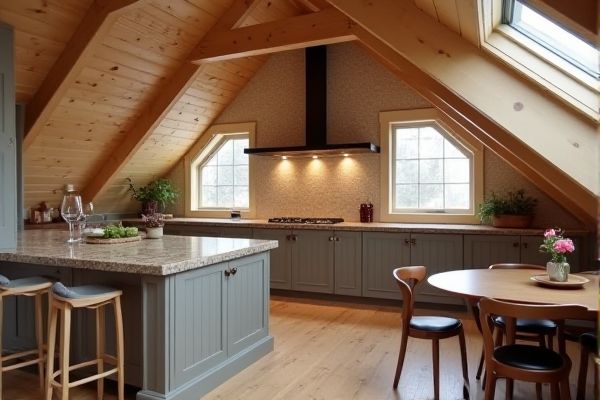
An attic kitchenette offers a fully equipped space with cooking appliances and storage, ideal for preparing meals, while an attic wet bar primarily focuses on beverage service with a sink and counter area, enhancing entertainment options. Discover the key differences and what suits Your lifestyle best by reading the rest of the article.
Table of Comparison
| Feature | Attic Kitchenette | Attic Wet Bar |
|---|---|---|
| Primary Function | Cooking and meal preparation | Drink mixing and serving |
| Equipment | Small stove, sink, mini fridge, cabinets | Sink, mini fridge, glassware storage, counter space |
| Space Requirement | Larger; requires ventilation and plumbing | Smaller; mainly plumbing and storage |
| Installation Cost | Higher due to appliances and ventilation | Lower; simpler setup |
| Typical Use | Light cooking, snacks, simple meals | Entertaining, cocktail preparation |
| Plumbing Needs | Sink and possibly stove gas or electric line | Sink only |
| Storage | Cabinets for food and cookware | Shelves for bottles and glassware |
| Ventilation | Required for cooking appliances | Optional or minimal |
| Ideal Users | Residents needing extra cooking space | Hosts who entertain frequently |
Introduction to Attic Kitchenettes and Wet Bars
Attic kitchenettes provide compact cooking and storage solutions, incorporating essential appliances such as mini refrigerators, microwaves, and small sinks to maximize space efficiency. Attic wet bars focus on beverage preparation areas equipped with sinks, countertop space, and storage for glassware and spirits, emphasizing entertainment and social gatherings. Both options transform underutilized attic spaces into functional, stylish zones tailored for convenience and hospitality.
Key Differences Between Attic Kitchenettes and Wet Bars
Attic kitchenettes typically include appliances such as a microwave, mini fridge, and sink for light cooking and food preparation, while wet bars are primarily designed for mixing and serving beverages, often featuring a sink, wine cooler, and storage for glassware. The layout of a kitchenette prioritizes functionality for preparing simple meals, whereas a wet bar emphasizes entertainment and socializing with seating and countertop space. Your choice depends on whether you need a versatile space for casual dining or a dedicated area for hosting and serving drinks.
Space Requirements and Layout Considerations
An attic kitchenette typically requires more space than an attic wet bar due to the need for appliances like a mini-fridge, sink, and countertop area for food preparation. Layout considerations for a kitchenette must include plumbing and electrical access to support cooking functions, while a wet bar focuses primarily on efficient use of limited space for beverage storage and serving. Optimizing an attic layout involves careful measurement to balance appliance size and storage needs, ensuring both functionality and comfort within confined spaces.
Essential Features of an Attic Kitchenette
An attic kitchenette typically includes essential features such as a compact sink, mini refrigerator, countertop space, and storage cabinets designed to maximize functionality within limited space. In contrast, an attic wet bar focuses more on beverage preparation, often featuring a small sink, wine fridge, and shelving for glassware and spirits. Your choice depends on whether you need full kitchen capabilities or a space primarily for entertaining and drink service.
Core Components of an Attic Wet Bar
An attic wet bar typically includes a sink with running water, a mini refrigerator, cabinetry for storage, and countertop space for mixing drinks, distinguishing it from an attic kitchenette which focuses on cooking appliances. Plumbing and electrical connections are essential core components to support the wet bar's functionality. Proper ventilation and durable materials ensure a practical and stylish setup for entertaining in an attic space.
Usage Scenarios: When to Choose a Kitchenette or Wet Bar
An attic kitchenette is ideal for extended stays or guest accommodations, providing essential appliances for cooking, reheating, and meal preparation. An attic wet bar suits social gatherings, offering a compact area for mixing drinks and serving refreshments without full cooking facilities. Your choice depends on whether your attic space prioritizes meal versatility or entertaining convenience.
Plumbing and Electrical Needs for Attic Installations
Attic kitchenettes require more extensive plumbing and electrical work than attic wet bars due to the need for sinks, appliances, and proper drainage systems. Installing electrical outlets and water lines must meet safety codes and accommodate ventilation for cooking equipment, which often increases complexity and cost. Your choice impacts installation timelines and ongoing maintenance, making careful planning essential for both functionality and compliance.
Design Ideas: Maximizing Small Attic Spaces
Attic kitchenettes often incorporate compact appliances, built-in cabinetry, and foldable furniture to maximize functionality in limited spaces, while attic wet bars focus on sleek countertops, under-counter refrigeration, and custom shelving for bottles and glassware. Utilizing vertical space with wall-mounted storage and multi-purpose islands enhances efficiency in both designs, transforming small attics into practical entertainment areas. Strategic lighting and open layouts further optimize the spatial perception, making either an attic kitchenette or wet bar a stylish and functional addition to compact attic environments.
Cost Comparison: Kitchenette vs. Wet Bar in the Attic
An attic kitchenette typically costs more than an attic wet bar due to the need for appliances like a refrigerator, microwave, sink, and cabinetry, with expenditures ranging from $5,000 to $15,000. In contrast, an attic wet bar generally requires fewer fixtures, mainly a sink, countertop, and storage, resulting in a lower cost bracket of $2,000 to $7,000. Your budget and intended use will significantly influence whether the added functionality of a kitchenette justifies the higher investment compared to a simpler wet bar setup.
Final Thoughts: Which Option Is Best for Your Attic?
Choosing between an attic kitchenette and an attic wet bar depends on your space, intended use, and lifestyle needs. An attic kitchenette offers full cooking capabilities and practical storage, ideal for guests or extended use, while an attic wet bar focuses on beverage service and compact design, perfect for entertaining or casual socializing. Assess the available square footage, plumbing options, and your entertainment priorities to determine the best fit for your attic renovation.
 homyna.com
homyna.com